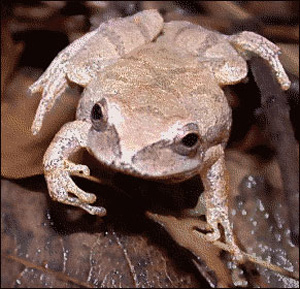The spring peeper is a tiny harbinger of spring. Its skin is light brown with darker markings, including a distinctive X-shaped mark on its back. It can darken or lighten it's skin color to better camouflage itself in only a few minutes. Male spring peepers are only 3/4 inches long, females can be up to 1 1/2 inches long.
Spring peepers range through most of the eastern half of the US and in eastern Canada. They are found throughout Connecticut and frequent moist areas in forests, fields and residential areas. Adults typically live on the forest floor, but return to shallow pools to breed and lay eggs. They can tolerate brackish water. Tadpoles live in the water until they reach maturity. Spring peepers are active during the warm season and shelter for the winter in a shallow, underground burrow, often under leaf litter. Spring peepers can survive being frozen. They are nocturnal.
Spring peepers are insectivores and hunt bugs by shooting out their sticky tongues to trap an insect and draw it back into their mouths. Spiders make up a large portion of their diet. Immature frogs, tadpoles, feed on plant matter.
Spring Peepers emerge from their burrows very early in spring, as soon as night temperatures begin to stay above about 40 degrees F. They head to wet areas with shallow water to sing mating calls and find a mate. Mating season may last up to two months and occurs between March and May. A male peeper grabs the female around her chest with his front legs and clings until she lays her eggs in the water. He deposits sperm on top of them. It is common for these frogs to mate and lay eggs in the shallows of larger bodies of water, in marshes, or in temporary spring pools (vernal pools). Spring peepers can also tolerate brackish water. Spring peeper eggs are laid individually or in small groups of 2 or 3 and attached to underwater vegetation. They can lay a total of 800 to 1000 eggs. In a few days the eggs hatch into small tadpoles. It takes about 6 to 8 weeks for the tadpoles to absorb their tails, grow legs and develop lungs, at which point they leave the water and hop off to begin life on land.
Spring peepers are solitary, except when they congregate in shallow pools to breed in the spring. The songs made by males during the breeding season are bell-like peeps that are surprisingly loud. The large groups of males that gather to sing in the spring produce a beautiful chorus that nevertheless is sometimes deafening at close range. Click the spring peeper call link below the photo for an example.
Male frogs produce their songs by inflating part of their mouth lining under their throat with air through an opening in the bottom of their mouths. They then close off their mouths and nostrils and pump air between their lungs and this vocal sac over their vocal chords. The vocal sac of a calling male spring peeper is about the diameter of a quarter and visible as a bubble under his throat. A few spring peepers may sing their distictive peeps in the fall during the period that day lengths and temperatures resemble those that occur in the spring.
Neat Facts
Spring peepers produce a natural anti-freeze that allows them to survive freezing temperatures while hibernating.
